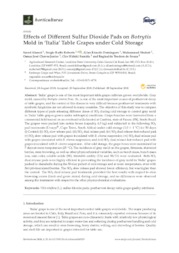Effects of different sulfur dioxide pads on botrytis mold in 'Italia' table grapes under cold storage.
Effects of different sulfur dioxide pads on botrytis mold in 'Italia' table grapes under cold storage.
Author(s): AHMED, S.; ROBERTO, S. R.; DOMINGUES, A. R.; SHAHAB, M.; CHAVES JUNIOR, O. J.; SUMIDA, C. H.; SOUZA, R. T. de
Summary: "Italia" grape is one of the most important table grape cultivars grown worldwide. Gray mold, caused by Botrytis cinerea Pers. Fr., is one of the most important causes of postharvest decay of table grapes, and the control of this disease is very difficult because postharvest treatments with synthetic fungicides are not allowed in many countries. The objective of this study was to compare different types of pads releasing different doses of SO2 during cold storage to control gray mold in "Italia" table grapes grown under subtropical conditions. Grape bunches were harvested from a commercial field trained on an overhead trellis located at Cambira, state of Parana (PR), South Brazil. The grapes were packed into carton boxes (capacity, 4.5 kg) and subjected to the following SO2 pad treatments (Uvasys®, Cape Town, South Africa) under cold storage (1.0 ± 1 °C) for 50 days: (i) Control; (ii) SO2 slow release pad; (iii) SO2 dual release pad; (iv) SO2 dual release? fast reduced pad; (v) SO2 slow release pad with grapes inoculated with B. cinerea suspension; (vi) SO2 dual release pad with grapes inoculated with B. cinerea suspension; and (vii) SO2 dual release-fast reduced pad with grapes inoculated with B. cinerea suspension. After cold storage, the grape boxes were maintained for 7 days at room temperature (25 °C). The incidence of gray mold on the grapes, firmness, shattered berries, stem browning, as well as other physicochemical variables, such as bunch mass, bunch mass loss, skin color, soluble solids (SS), titratable acidity (TA) and SS/TA were evaluated. Both SO2 dual release pads were highly efficient in preventing the incidence of gray mold in ?Italia? grapes packed in clamshells during the 50-day period of cold storage and at room temperature, even with Botrytis-inoculated berries. The SO2 slow release pad showed lower efficiency, but was higher than the control. The SO2 dual release pad treatments provided the best results with respect to stem browning scores (fresh and green stems) during cold storage, and no differences were observed among the treatments with respect to the other physicochemical evaluations. Keywords: Vitis vinifera (L.); sulfur dioxide pads; postharvest decay; table grape quality attributes
Publication year: 2018
Types of publication: Journal article
Unit: Embrapa Grape & Wine
Observation
Some of Embrapa's publications are published as ePub files. To read them, use or download one of the following free software options to your computer or mobile device. Android: Google Play Books; IOS: iBooks; Windows and Linux: Calibre.
Access other publications
Access the Agricultural Research Database (BDPA) to consult Embrapa's full library collection and records.
Visit Embrapa Bookstore to purchase books and other publications sold by Embrapa.

